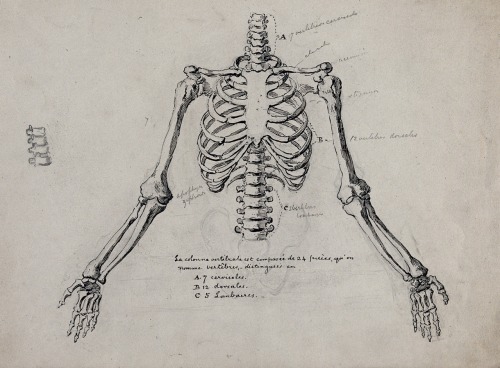The Upper Half Of A Skeleton Without The Skull. Pen And Ink Drawing.

The upper half of a skeleton without the skull. Pen and ink drawing.
More Posts from Mariaagnesi-fangirl-blog and Others

Rare Collision Between Four Galaxy Clusters

new work available on redbubble


“Patristic literature associates the timing of the Circumcision on the eighth day with the Resurrection. Here the argument rests on the kind of mystical numerology which we no longer take seriously, but it did formerly engage so great minds. The reasoning runs somewhat as follows. Seven is the number of completion and fullness, for the world was created in seven days, and is due to pass through seven ages. But if seven is perfect, then seven-plus-one is pluperfect. Eight, therefore, stands for renewal, regeneration - whence the architectural tradition of eight-sided baptistries. And Christ rose from the dead on the day superseding the Sabbath, on the eight day; just as the world’s seven ages will be followed in the eighth age by the General Resurrection. These notions attach themselves almost from the beginning to all theological meditation on Christ’s circumcision. From St. Justin Martyr in the 2nd century to St. Thomas Aquinas, it is the sense of the mystery that the Circumcision on the eighth day prefigures Christ’s Resurrection, and thereby, implicitly, the resurrection of all.”
— Leo Steinberg (The Sexuality of Christ in Renaissance Art and in Modern Oblivion, page 52). On the next page he quotes Bede, “[It is] our true and complete circumcision, when, on the day of judgment, all souls having put off the corruption of the flesh … we will enter the forecourt of the heavenly kingdom to behold forever the face of the Creator. This is prefigured by the circumcision of the little ones in the temple of the Lord in Jerusalem.”
Generic Coding Tips
>> Know the intent of your code. What is the purpose of your code? What should the inputs be? What should it output? It can be useful (especially for larger projects) to write out a flow chart that maps how information moves from task to task through the program.
>> Divide your code into sections that fulfill specific tasks, then chain them together. Sometimes it’s worth devoting a code section to its own file to be used by multiple programs rather than coding multiple instances of the same thing into each program. Consider what tasks might be useful for future programs.
>> Create a main project folder and don’t be afraid to use subfolders. Folder hierarchies are your friend when it comes to juggling multiple files in an easy-to-understand manner.
>> Consider having a “resources” subfolder, with pdfs, webpages, etc. of information relevant to your project. For example, I’m currently working on a program to calculate relic densities, so my project folder has a resource subfolder with research papers about relic densities.
>> Comment your code! Seriously, future you will appreciate it. (I usually also keep a README.txt file in the same folder which describes how to implement the code.) In the same vein, explicitly state any conventions you’re using and where you’re getting any data you import.
>> Test each section as you build it. Throw in sample values (preferably where you know what the output should be) periodically and make sure it’s doing what you want it to do!
>> SAVE WORKING VERSIONS OF YOUR CODE. Do you have a working build? Save it, then–before augmenting anything–create a new file and work on the next version of the code there. I do this usually via “save” and then “save as”. Version control is to coding as save points are to video games.
>> Generating a lot of data? Consider saving a sample instance of that data in a subfolder. It can be a massive pain to troubleshoot portions of your program if you have to wait to generate hundreds of data points every time you run it.
>> Getting an unknown error in a massive amount of code? Isolate the section of code containing the error(s), then create a minimal working example of the section, and keep adding to that example until you either figure out 1. why your original code failed, or 2. until you’ve constructed a new functioning code.



truckers chapel



Tickling the Dragon’s Trail with the Demon Core
“Gentleman, what we have here is the most powerful force ever created by mankind. Lets poke at it with a screwdriver.”
—Louis Slotin, Los Alamos laboratory
After World War II the scientists at Los Alamos laboratory found themselves in possession of a spare core originally intended for a nuclear bomb. Nicknamed ‘“Rufus” the core would have been detonated as part of a third nuclear bomb dropped on Japan, however the Japanese surrendered before the bomb could be assembled. Instead the 89mm (3.5 inch) diameter sphere of plutonium-gallium was reserved for scientific testing, in particular criticality experiments.
Critical mass is the minimum amount of mass needed for a fissile material to sustain a nuclear chain reaction. When a fissile material reaches critical mass, it becomes “supercritical”, where it releases a large amount of energy. Rufus was 5% subcritical, thus scientists thought it was ideal for use in criticality experiments. The experiment was designed to simulate critical mass by surrounding the core with neutron reflectors, in this case tungsten carbide bricks. The bricks would deflect released neutrons back into the core, increasing it’s reactivity. Completely surrounding the core would cause it to go supercritical, an event which was to be avoided because it would release a burst of neutron radiation that could kill everyone in the room. Essentially the purpose of the experiment was to see how much nuclear material could be added to the core before it would go supercritical, and measure how much energy is released in the process.
On August 21st, 1945 physicist Harry K. Daghlian Jr. (pictured above left)was conducting a criticality experiment with Rufus when he accidentally dropped a tungsten carbide brick on the core. The core went supercritical, releasing a burst of neutron and gamma radiation while bathing the room in a bright blue light. Daghlian promptly responded by removing the brick from core, causing his hand to instantly blister from the radiation.

Daghlian had received a deadly dose of radiation, resulting in his death 25 days later. An accompanying guard, Army Private Robert J. Hemmerly, was sitting at a desk 12 feet away but seemed unharmed by the accident, although he would die 33 years later from leukemia.
After the accident, Rufus was renamed, “The Demon Core”. A new procedure was designed to make the experiment “safer”, which was designed by physicist Louis Slotin (pictured above, right). The new procedure involved the core sitting between two beryllium half spheres. A screwdriver was jammed in between the two half spheres, creating a gap through which neutrons could escape. The screwdriver was used to manipulate the half spheres, raising or lowering them to increase or decrease the size of the gap, thus increasing or decreasing the reactivity of the core. If the two half spheres completely enclosed the core, it would go supercritical.

If this sounds completely bonkers, you probably have more common sense than the brilliant physicists who conducted these experiments. In fact the experiment was named “Tickling the Dragon’s Tail”, based on a remark by physicist Richard Feynman who compared the experiment to “tickling a sleeping dragon”. Slotin was certainly aware of the dangerous nature of the experiment, he had been at Daghlian’s bedside when he had died. The famed physicist Enrico Fermi had warned Slotin that if he continued these criticality experiments, he would be dead within a year.
On May 26th, 1946 Slotin was conducting a criticality experiment with the demon core when he lost control of his screwdriver, causing the beryllium sphere to close. The incident is almost perfectly re-enacted in the 1989 film “Fat Man and Little Boy”,
Louis Slotin died of acute radiation poisoning nine days later. Of the other seven people in the room, two would die of cancer years later, although it is unknown whether the accident contributed to their deaths.
After these two criticality accidents new experiments were designed which used remote controlled machines and cameras. The Demon Core was melted down and recycled into other cores.
Method of Reciting the Rosary for the Poor Souls in Purgatory
Here we pray the Sorrowful Mysteries. Before each decade, we pray what concerns the particular mystery, and instead of ending the decades with Glory Be…, we pray: Lord, grant them eternal rest and let perpetual light shine upon them!
Begin the Rosary normally, and then before the first decade is prayed, but after the 1st Sorrowful Mystery is stated, pray: Lord, Jesus Christ, through Thy bloody sweat of fear that Thou didst shed on the Mount of Olives, we ask Thee to have mercy on the Poor Souls in Purgatory. Deliver them from their fear and pain and console them with the cup of heavenly comfort!
Before the second decade is prayed, but after the 2nd Sorrowful Mystery is stated, pray: Lord Jesus Christ, through Thy painful Scourging which Thou didst tolerate so patiently for us sinners, we ask Thee to have mercy on the Poor Souls in Purgatory. Retract from them the pain of Thy anger and give them eternal rest!
Before the third decade is prayed, but after the 3rd Sorrowful Mystery is stated, pray: Lord Jesus Christ, through Thy painful Crowning which Thou didst suffer so patiently for us sinners, we ask Thee to have mercy on the Poor Souls in Purgatory, and give them the crown of eternal delight!
Before the fourth decade is prayed, but after the 4th Sorrowful Mystery is stated, pray: Lord Jesus Christ, through Thy painful Carrying of the Cross, which Thou didst suffer so patiently for us sinners, we ask Thee to have mercy on the Poor Souls in Purgatory. Remove from them the heavy burden of suffering and lead them into eternal peace!
Before the fifth decade is prayed, but after the 5th Sorrowful Mystery is stated, pray: Lord Jesus Christ, through Thy painful Crucifixion, which Thou didst suffer so patiently for us sinners, we ask Thee to have mercy on the Poor Souls in Purgatory. Turn Thy Holy Face toward them and let them today be in Paradise with Thee!
After praying the last decade, we pray: Lord Jesus Christ, through Thy five Holy Wounds and through all of Thy Sacred Blood that Thou didst shed, we ask Thee to have mercy on the Poor Souls in Purgatory, and in particular for our parents, relatives, spiritual guides, and benefactors. Heal their painful wounds and let them enjoy and participate fully in Thy Salvation. Amen.




Howl’s Moving Castle (2004)
-
 5732h liked this · 8 months ago
5732h liked this · 8 months ago -
 eerie--eyed reblogged this · 8 months ago
eerie--eyed reblogged this · 8 months ago -
 thebeinginyourwalls liked this · 1 year ago
thebeinginyourwalls liked this · 1 year ago -
 unrihensi liked this · 1 year ago
unrihensi liked this · 1 year ago -
 anindoorskat liked this · 2 years ago
anindoorskat liked this · 2 years ago -
 derjaegermond-arc reblogged this · 2 years ago
derjaegermond-arc reblogged this · 2 years ago -
 gravyard-criters liked this · 3 years ago
gravyard-criters liked this · 3 years ago -
 captain-boobie liked this · 3 years ago
captain-boobie liked this · 3 years ago -
 anyaaaab liked this · 3 years ago
anyaaaab liked this · 3 years ago -
 thr3-sh reblogged this · 3 years ago
thr3-sh reblogged this · 3 years ago -
 maximumrgrt reblogged this · 3 years ago
maximumrgrt reblogged this · 3 years ago -
 maximumrgrt liked this · 3 years ago
maximumrgrt liked this · 3 years ago

"There is a pre-established harmony between thought and reality. Nature is the art of God." - Gottfried Willhelm Leibniz
164 posts